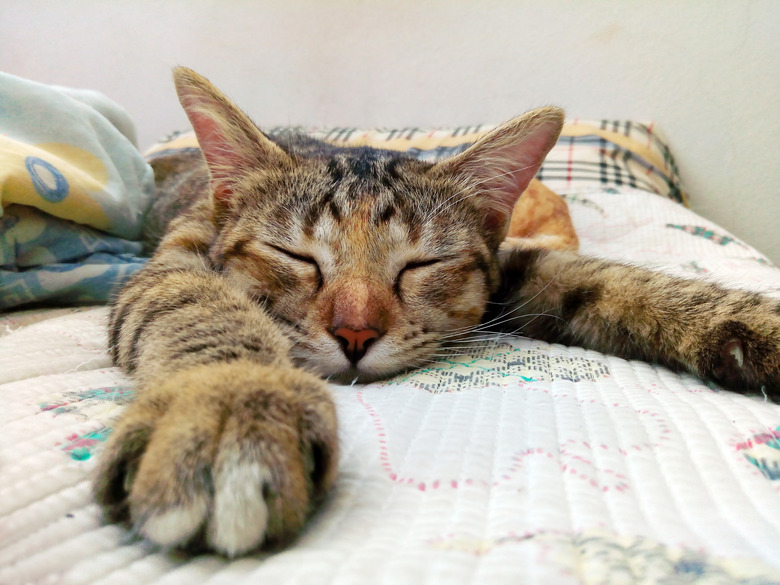Medication Used To Sedate A Cat
It seems like cats are never not sleeping. And that's because they do sleep a lot — most average 14 to 16 hours per day. So it might be difficult to think of a scenario when you'd want a cat to sleep more, but there are quite a few circumstances that do call for sedation, such as for travel or medical procedures.
Understanding how sedatives work and which situations they should be used for your cat are an important part of being a pet owner.
Cats who are aggressive or anxious and ones who obsessively spray are also candidates for sedatives. If you think your kitty needs a sedative, it is imperative that you only sedate them using prescribed medication, and under your veterinarian's care. Always consult an experienced veterinarian regarding the health and treatment of your cat.
Inhalable medications used as a cat sedative
Inhalable medications used as a cat sedative
There are different forms of medications used to anesthetize cats putting them into a more-than-sedate state, including halothane, isoflurane and sevoflurane. All of these medications are in gas form. Not many cats will sit still long enough for a mask to be placed over their mouths and noses, and then for the medication to take effect.
To accomplish this, typically the cat is placed in an acrylic box into which a combination of oxygen and the gas is pumped. The mixture must be balanced and adjusted for the individual cat. Further, the cat's weight and facial structure are factors. Additionally, some breeds are more sensitive than others to anesthesia.
Sedation via injection for cats
Sedation via injection for cats
Acepromazine, diazepam, and ketamine are cat sedatives that are administered through injection, though acepromazine and diazepam are also available as a pill. The vet determines the correct dosage for drugs like acepromazine based upon your cat's weight. Cats tend to be sensitive even to ordinary amounts of some drugs like acepromazine, though, so it's common for a vet to divide the calculated dose into several small doses and administer them separately until the drug takes effect.
Oral cat sedative medications
Oral cat sedative medications
Sedatives in pill form are likely the only tranquilizing medications you would personally give your cat unless your vet has trained you to give a tranquilizer for cats via injection. Buspirone and alprazolam are pills that might be prescribed as cat sedative medications. Vets more commonly use buprenorphine, acepromazine, and gabapentin for cats.
Gabapentin is technically an anti-seizure medication rather than a cat sedative, and buprenorphine is an analgesic; however, both medications still cause sedation in cats. While veterinarians used some of these medications more often historically, gabapentin is now the most common anesthetic for cats.
How to pill a difficult cat by yourself
How to pill a difficult cat by yourself
Cats aren't known for willingly taking medication like gabapentin for cats, so getting a cat sedative pill down your kitty's throat can be difficult and could end up in bloody scratches and hurt feelings. Try hiding the cat sedative in a treat or your cat's food, adding a tempting flavor enhancer such as tuna juice. Gabapentin for cats also comes in powdered form, which is simple to mix into your cat's food and won't be as noticeable to your cat as a pill in the food.
If they are too clever to fall for oral medications in their food, kneel over your cat on the floor, with one leg on each side. You should both be facing the same direction so you can place the thumb and middle finger of one hand on either side of their jaw to gently open their mouth. Use the forefinger of your other hand to place the pill as far back on their tongue as you can. Allow them to close their mouth, but don't let them run off before you see that they've swallowed their pill and hasn't spit it out.
It's not the easiest to ensure your cat takes their pill, but there are some tips for making it happen. Since pills swallowed without water can sit in your cat's throat for a long time (and therefore not work), have a 3 cc syringe (no needle) or dropper filled with water on standby. After pilling, hold your cat's mouth closed and put the tip of the dropper just inside the corner of your cat's mouth. Slowly add water until they swallow once.
What are the common side effects of cat sedatives?
What are the common side effects of cat sedatives?
No medications are free from side effects. Common consequences of sedatives in cats include vomiting, hypotension, increased appetite, anxiety, hallucinations, disorientation, diarrhea, and restlessness. Sometimes sedation is considered a side effect of a drug, as with buspirone that also indicates increases friendliness in cats (but in some cases, can also cause feline aggression).
Over-the-counter sedatives for cats
Over-the-counter sedatives for cats
Some people forgo consulting a vet when they want to sedate their cats with cat sleeping pills for something routine such as travel, and opt to medicate their kitties with an over-the-counter antihistamine such as diphenhydramine. Even though you can purchase them, these drugs are manufactured for humans and can negatively affect your cat. Gabapentin for cats for travel should be prescribed by a veterinarian; don't give your cat gabapentin prescribed to a human. Sleeping pills for cats seem like a quick solution, but always discuss cat medication with your pet's veterinarian first.
You should never take it upon yourself to medicate your cat without talking to your veterinarian first. Sedation is one side effect, but others can include: dry mouth, problems urinating, vomiting and/or diarrhea, loss of appetite or anxiety and agitation. Additionally, avoid using diphenhydramine with cats who have glaucoma or high blood pressure.


